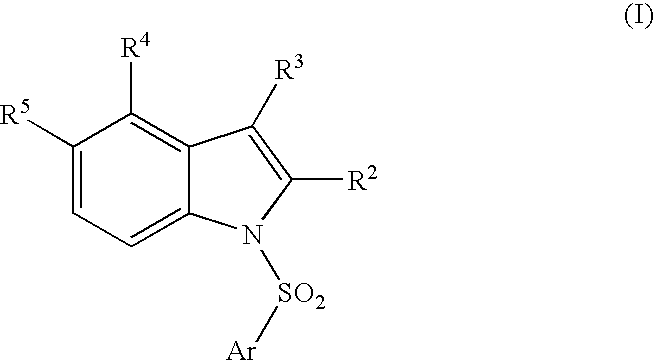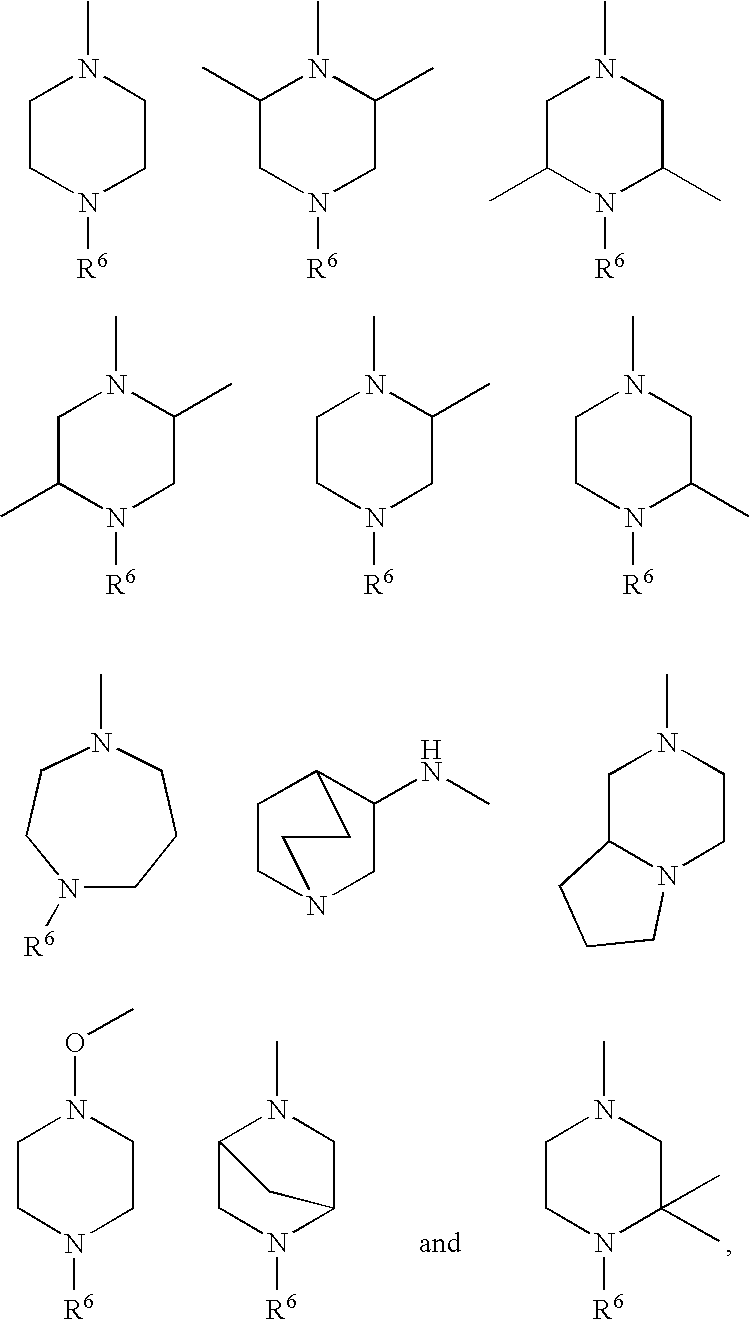Novel compounds, their use and preparation
a technology of compounds and compounds, applied in the field of new compounds, can solve problems such as major health problems and increased mortality
- Summary
- Abstract
- Description
- Claims
- Application Information
AI Technical Summary
Problems solved by technology
Method used
Image
Examples
example 1
Intermediate
4-Bromo-1-(tri-isopropylsilyl)-1H-indole (Scheme 1)
[0099] The NaH 60% dispersion in oil (0.94 g, 23.4 mmol) was added to a solution of 4-bromoindole (3.07 g, 15.6 mmol) and triisopropylsilyl chloride (3.62 g, 18.8 mmol) in CH2Cl2 (50 mL) and DMF (2 mL). The reaction was stirred at room temperature for 1 h and quenched with water. The insoluble material was filtered off and the solvent was removed. Purification by column chromatography (SiO2, CH2Cl2 / heptane 1:4) yielded 3.44 g (63%) of the title compound: 1H NMR (CDCl3) δ 7.42-6.63 (m, 5H), 1.66 (sept, J=8 Hz, 3H), 1.10 (d, J=8 Hz, 18H; MS (ESI) 354.4 (M+H)+; Purity (HPLC) >95%.
example 2
Intermediate
N-tert-Butyl-trimethylsilyl-4-chloroindole (Scheme 1)
[0100] 4-Chloroindole (131.1 g, 0.871 mol) was dissolved in dry THF (0.5 L). The solution was chilled to 0° C. (ice bath, stirring). t-BuOK (97.6 g, 0.871 mol) was added in one portion and the stirring was continued for additional 5 minutes, Tert-butyldimethylchlorosilane (131.3 g, 0.871 mol) was added portionwise over 10 min with a good stirring. The reaction is exothermic. After 30 minutes the reaction was quenched with water (20 ml) and pH was adjusted to 8-9 and extracted with ethyl acetate (3×50 mL). The organic phases were dried (MgSO4), filtered and the volatiles were eliminate by vacuum. The residue was triturated and crystallized from heptane to yield 181 g (78%) of the title compound. 1H NMR (CDCl3) δ 7.45 (dd, J=7.9 Hz, J=0.8 Hz, 1H), 7.25 (d, J=3.0 Hz, 1H), 7.18-7.07 (m, 2H), 6.77 (d, 1H), 0.96 (s, 9H), 0.62 (s, 6H); 13C NMR (CDCl3) 141.8; 131.7; 130.3; 125.9; 122.0; 119.7; 112.5; 103.5; 26.3; 19.5; −3.9;...
example 3
Intermediate
4-(4-Methyl-1-piperazinyl)-1-(triisopropylsilyl)-1H-indole (Scheme 1)
[0101] The compound was prepared according to Method 2 from 4-bromo-1-(triisopropylsilyl)indole (0.090 g, 0.255 mmol), t-Bu3P (3.6 mg, 0.014 mmol), and Pd (OAc)2 (1 mg, 0.0036 mmol) in xylene (3 mL) and 4-methyl-1-piperazine (0.135 g, 0.73 mmol) and NaOt-Bu (69 mg, 0.72 mmol). The crude was purified by column chromatography (SiO2, CH2Cl2 / heptane 1:4) to yield 90 mg (84%) of pure material: 1H NMR (CD3OD) δ 7.19-6.56 (m, 5H), 3.31-3.25 (m, 4H), 2.71-2.63 (m, 4H), 2.36 (s, 3H), 1.76 (sept, J=8 Hz, 3H), 1.11 (d, J=8 Hz, 18H); MS (ESI) 372.5 (M+H)+; Purity (HPLC) >95%.
PUM
| Property | Measurement | Unit |
|---|---|---|
| Volume | aaaaa | aaaaa |
| Volume | aaaaa | aaaaa |
| Volume | aaaaa | aaaaa |
Abstract
Description
Claims
Application Information
 Login to View More
Login to View More - R&D
- Intellectual Property
- Life Sciences
- Materials
- Tech Scout
- Unparalleled Data Quality
- Higher Quality Content
- 60% Fewer Hallucinations
Browse by: Latest US Patents, China's latest patents, Technical Efficacy Thesaurus, Application Domain, Technology Topic, Popular Technical Reports.
© 2025 PatSnap. All rights reserved.Legal|Privacy policy|Modern Slavery Act Transparency Statement|Sitemap|About US| Contact US: help@patsnap.com



